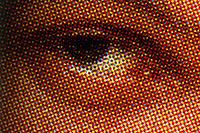Why Is Red, Red?
 Cones Are Stimulated by Light.1 |
For the same reason that blue is blue: some light waves are longer than others. For visible colors, red waves are the longest and violet the shortest. It’s similar to sound where low notes (bass) have much longer waves than high notes (treble).
How Do We See Color? Light entering the eye stimulates rods and cones on the retina. The cones are sensitive to color: some primarily to red, others to green or blue. Pure red light mostly stimulates the red cones while yellow stimulates both red and green. Color blindness occurs when some or all of these sensors don’t work properly.
How Do We Make Color? Computers use color to print photos, display web graphics and enhance PowerPoint presentations. In each case they must produce light waves that will stimulate the appropriate cones in the eye, but it is done differently depending on whether the color is to be viewed on a monitor or printed.
Red, Green and Blue Subpixels.2 |
Monitor Color Is RGB. Computer monitors emit light; place one in an otherwise dark room and it glows.
The image it displays is created by the illumination of thousands of tiny dots called pixels. Each pixel has three light-producing elements: one for red light, another for green and a third for blue. The computer determines how much red, green and blue each pixel should produce. All three off makes black; all three at full brightness makes white; combinations in between produce the millions of colors necessary for photo-realistic images.
Color produced by combining red, green and blue frequencies in this way is sometimes called "Additive Color."
 Enlarged Sample of CMYK Dots. |
Printed Color Is CMYK. While a computer monitor generates its own light, a printed page does not. We can see the page because it reflects light from the Sun or a light bulb to our eyes. In a totally dark room, we can’t see the document at all.
An American flag appears red, white and blue because its pigments reflect only those light frequencies. With custom-mixed paints and dyes, you can create any color, but because computer printers can only handle a few inks at a time, they simulate the rainbow by printing patterns of tiny cyan, magenta and yellow dots (see illustration). Black ink is usually also used for text and pure black in images. Together these colors can simulate nearly the entire rainbow. When you see CMYK, the K stands for black.
Because a colored object absorbs the frequencies of light it doesn’t reflect, color produced this way is sometimes called "Subtractive Color."
-----
- Diagram based on "Three Main Layers of the Eye," by Holly Fischer. Wikipedia.
- Image by Peter Halasz, Wikimedia Commons.
This article originally appeared in our free semi-monthly newsletter. To receive future issues, please add your name to the subscription list.

